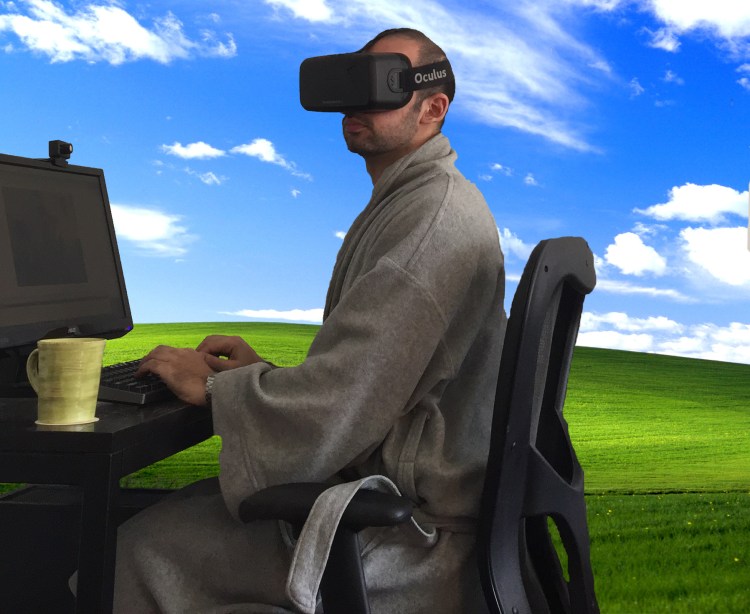Nascent entrepreneurs and seasoned pajama warriors know that working from home is life-changing … and also kind of sucks. That’s why WeWork’s valuation is $16 billion and why the most popular product in a coffee shop is the power outlet. As VR headsets shrink and pixel densities balloon, working from home will not only suck less, it’ll eclipse all alternatives. Goodbye coffee-crusted keyboards and expensive shared tabletops. The combination of VR workspaces and adaptive machine learning will make plugged-in workers more creative, productive, and socially connected than their commuting peers.
VR will make you more creative
Creativity hates monotony, and home is a step away from prison. People take their laptops elsewhere to spice up their week and spark new ideas. Scientists confirm that ambient noise, like a barista’s clanging, increases creativity. Important too are ambient sights. Having interesting stuff to look at when you need a break helps you recharge. Home has a glaring lack of ambient anything, unless you count that spider in the corner.
VR will kindle your creativity with 3D ambient sounds and endless ambient sights. Think distant whale calls and frolicking husky pups. Because one person’s muse is another’s nuisance, your VR workspace will use machine learning to personalize ambiance in order to maximize your creativity. Do you have your best ideas in a hopping jazz club or alone in a quiet meadow? Under bright lights or aglow in magic hour? Your VR workspace will figure that out and, more importantly, change it on the fly to adapt to your output. Just because on average you’re at your best under a starry sky doesn’t mean you should always work under a starry sky.
VR will personalize your environment while you personalize your unique style. Michael Pinto, Creative Director at verymemorable.com, works out of an office because he enjoys making daily fashion choices and might otherwise stay in his pajamas. Choosing an outfit kickstarts his day with a creative flourish. With VR your fashion choices won’t be limited to your closet. You’ll dress your avatar in a trillion combinations or let your computer surprise you.
You’ll also dress up your space. Pet dragons instead of action figures and looping holographic video instead of framed photos. VR will unleash more creative, personal empowerment than the quirkiest startup snack room.
VR will make you more productive
Home is distracting. Your family bugs you in the middle of a thought, and your bed always beckons. No one’s looking over your shoulder, so you fall into the abyss of social media. With VR, your physical distractions melt away, your digital distractions are programmed away, and your family will stay far away: Nothing screams “I’m busy!” more than a mask and thick headphones.
It’s hard to focus when your computer has a dozen notifications flashing for your attention. Your virtual workspace will automatically disable Facebook and VentureBeat to keep you on task. Save your favorite diversions for when you’re headset free.
Productivity is knowing when to take breaks. Many lifehackers swear by the Pomodoro Technique, which combines 25-minute work sprints with 5-minute breaks. The problem with taking breaks is that it’s easy to skip them when work is going well or extend them when you’re feeling lethargic. And productivity varies throughout the day, so a constant 25-5 split can’t be optimal. Your VR workspace will know when to leave you alone, perhaps based on your eye movements and keystrokes and blood pressure, and when to teleport you into an art museum for a 10-minute breather.
Dual-monitor setups used to be weird. In the future, all monitors will be weird. Instead of jamming your workflow into a one-size-fits-all rectangle of pixels, your data will float in front of you, stretching and rotating fluidly. Never again will you have to Alt-Tab through a dozen stacked windows. And if you’d like to share what’s on your screen, flick your wrist and it’ll appear on a movie theater sized billboard.
VR will make you less lonely
Before you chuckle at the notion that sitting alone at home with a box over your head can ever be a substitute for real human contact, remember that multi-player games like World of Warcraft have already accomplished this feat with far less immersion (and even saved lives by doing so).
You’ll never be alone with VR. Your VR workspace will invite hundreds of people from around the world to sit nearby. Introduce yourself to those who share your profession or favorite hobby. Let your big data overlord recommend a new friend or keep to yourself with a “leave me be” notification. One of the main reasons hackathons are successful is that they introduce designers to developers to product people. Your VR workspace will do that every day.
How about sounding boards? If you want to kick around an idea, summon a focus group and share your work. Don’t worry about office etiquette. Play loud music, take a dance break, or shoot spitballs. You’ll always be the most important person in the room (or the beach or the space station …).
We’re almost there!
VR isn’t there yet, but it’s shockingly close. Apps like Virtual Desktop and AltSpaceVR are good first steps. There will be uncomfortable drawbacks, like the idea that your boss can monitor your glances or that your FitBit will hate you. Still, for many people who work from home, VR workspaces will be a literal dream come true.
Note: As a stunt I tried to write this article on the Oculus DK2. I lasted 10 minutes because the resolution gave me a headache. Hopefully the upcoming Oculus CV1 will fare better!
Adam Ghahramani is head of digital product for a creative agency in New York City. Find him at adamagb.com or make friends on Twitter (@adamagb).


